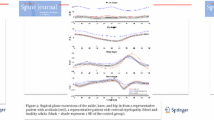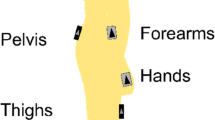Abstract
The Romberg sign helps demonstrate loss of postural control as a result of severely compromised proprioception. There is still no standard approach to applying the Romberg test in clinical neurology and the criteria for and interpretation of an abnormal result continue to be debated. The value of this sign and its adaptation when walking was evaluated. Detailed clinical examination of 50 consecutive patients of cervical myelopathy was performed prospectively. For the walking Romberg sign, patients were asked to walk 5 m with their eyes open. This was repeated with their eyes closed. Swaying, feeling of instability or inability to complete the walk with eyes closed was interpreted as a positive walking Romberg sign. This test was compared to common clinical signs to evaluate its relevance. Whilst the Hoffman’s reflex (79%) was the most prevalent sign seen, the walking Romberg sign was actually present in 74.5% of the cases. The traditional Romberg test was positive in 17 cases and 16 of these had the walking Romberg positive as well. Another 21 patients had a positive walking Romberg test. Though not statistically significant, the mean 30 m walking times were slower in patients with traditional Romberg test than in those with positive walking Romberg test and fastest in those with neither of these tests positive. The combination of either Hoffman’s reflex and/or walking Romberg was positive in 96% of patients. The walking Romberg sign is more useful than the traditional Romberg test as it shows evidence of a proprioceptive gait deficit in significantly more patients with cervical myelopathy than is found on conventional neurological examination. The combination of Hoffman’s reflex and walking Romberg sign has a potential as useful screening tests to detect clinically significant cervical myelopathy.
Similar content being viewed by others
References
Bemhardt M, Hynes RA, Blume HW, White AAIII (1993) Current concepts review. Cervical spondylotic myelopathy. J Bone Joint Surg Am 75(1):119–128
Glaser JA, Curé JK, Bailey KL, Morrow DL (2001) Cervical spinal cord compression and the Hoffmann sign. Iowa Orthop J 21:49–52
Heffez DS, Ross RE, Shade-Zeldow Y, Kostas K, Shah S, Gottschalk R, Elias DA, Shepard A, Leurgans SE, Moore CG (2004) Clinical evidence for cervical myelopathy due to chiari malformation and spinal stenosis in a non randomised group of patients with the diagnosis of fibromyalgia. Eur Spine J 13(6):516–523. doi:10.1007/s00586-004-0672-x
Lanska DJ (2000) 19th century contributions to the clinical assessment and mechanical recording of postural sway. Arch Neurol 58:1147–1150. doi:10.1001/archneur.58.7.1147
Lanska DJ, Goetz CG (2000) Romberg’s sign-development, adoption and adaptation in the 19th century. Neurology 55:1201–1206
Lanska DJ (2002) The Romberg sign and early instruments for measuring postural sway. Semin Neurol 22(4):409–418. doi:10.1055/s-2002-36763
Muybridge E (1979) Abnormal movements, males and females (nude and semi-nude). In: Muybridge E (ed) Muybridge’s complete human and animal locomotion, vol 2. Dover publications Inc, New York, pp 1081–1139
Ono K, Ebara S, Fuji T, Yonenobu K, Fujiwara K, Yamashita K (1987) Myelopathy hand-new clinical signs of cervical cord damage. J Bone Joint Surg Br 69(2):215–219
Rao R (2002) Neck pain, cervical radiculopathy and cervical myelopathy: Pathophysiology, natural history and clinical evaluation. J Bone Joint Surg Am 84-A:1872–1881
Rogers JH (1980) Romberg and his test. J Laryngol Otol 94:1401–1404
Shumway-Cook A, Horak FB (1986) Assessing the influence of sensory interaction on balance: suggestion from the field. Phys Ther 66:1548–1550
Singh A, Crockard HA (1999) Quantitative assessment of cervical spondylotic myelopathy by a simple walking test. Lancet 354(9176):370–373. doi:10.1016/S0140-6736(98)10199-X
Sung RD, Wang JC (2001) Correlation between a positive Hoffmann’s reflex and cervical pathology in asymptomatic individuals. Spine 26(1):67–70. doi:10.1097/00007632-200101010-00013
Weber PC, Cass SP (1993) Clinical assessment of postural stability. Am J Otol 14(6):566–569
Wong TM, Leung HB, Wong WC (2004) Correlation between magnetic resonance imaging and radiographic measurement of cervical spine in cervical myelopathic patients. J Orthop Surg (Hong Kong) 12(2):239–242
Author information
Authors and Affiliations
Corresponding author
Rights and permissions
About this article
Cite this article
Findlay, G.F.G., Balain, B., Trivedi, J.M. et al. Does walking change the Romberg sign?. Eur Spine J 18, 1528–1531 (2009). https://doi.org/10.1007/s00586-009-1008-7
Received:
Revised:
Accepted:
Published:
Issue Date:
DOI: https://doi.org/10.1007/s00586-009-1008-7




